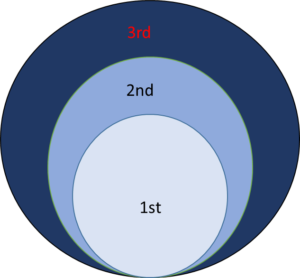According to the Circular Economy, we must adopt a systemic mindset: “Think in’systems. Understanding the interaction between the total and the pieces as well as how different components affect one another within a whole is essential. Components are taken into account in respect to their social, environmental, and infrastructure environments.
The Doughnut Economic Model also aims to restructure societies’ modes of production and habitation in accordance with the constraints and bounds of social justice and eco systems. We can ask: Are these systemic techniques stable or dynamic as we look more closely at them. They may be outside of us or all around us as fixed structures, and it is important to comprehend and care for them until they go. Several systems may come together or should function in concert if we consider them to be integrated aspects. Systems become full and dynamically alive as opposed to the sum of their components when we as humans expand our capacity to recognize them as whole living creatures. A whole is essentially just one singular entity in which all kinds of energies and processes are taking place; it is not the sum of its components or the consequence of the interactions between them.
The aforementioned graphs show us how two different perspectives on and relationships with systems differ. In the first, a business is in the middle of “integrating” various system components as parts that need be taken into account while designing the business system and its operations. The second depicts no things coming together; rather, it demonstrates how the company is a part of a larger system in which live dynamics take place. It provides a w-holistic perspective on life. The concept of layered systems is essential for improving our understanding of what ecosystems are and how they function. Based on what we recently discovered about systemic viewpoints and impacts, the following questions can help us focus our reflection:
- What would be expected of us in order to promote working methods based on the nested systems approach as business owners, corporate decision makers, and investors?
- How might this improve the circular approaches at the company’ operational level? How would that enable us to change the location where we do our business as producers?
- How would doing so affect the systems that our businesses rely on for health and wealth, and what advantages would they have?
- In what new way would it then enable us to comprehend economic dynamics?
Even if circular economics is accepted and utilized to rethink employment in some towns and industries, their attention is presumably where the problem lies. On the one hand, the Circular Economy Model limits our ability to influence economic dynamics and contribute to living systems by concentrating primarily on the chain of manufacturing, distributing, and consuming commodities. Raworth’s approach, on the other hand, goes a bit farther and leads us to believe that this is a multidimensional issue rather than a one-dimensional or bi-dimensional one. Even so, a human-centered approach still limits the scope of the multidimensional perspective. More than just removing garbage and preserving or rebuilding natural systems is the goal. Yet, even when considering regeneration, McArthur and Raworth’s two specific approaches still draw on assumptions and notions that are part of the arrest disorder paradigm. What must we do in order to change over to the Regenerate Life Paradigm?
Only by recognizing these two elements We can start drafting a new way of thinking that will allow us to really innovate from the very distinctiveness of the system and, as a result, design our work to truly make a contribution through regenerative processes. 1) Going beyond stopping the loss we end up causing as part of our producing-consuming activities; and 2) the need to shift from a fragmented approach to comprehending systems to a w-holistic way.
These insights have had a profound impact on how we, as a company, approach change. We understood that, in order to accomplish higher-level objectives, we must alter the way we approach problem-solving and implement fresh approaches that go beyond incremental improvements.
We are simply trying to mitigate or neutralize damages, which means we are aspiring to change at the level of arresting disorder, by redesigning how we work in a factory to still provide the products or services we create, by sourcing quality materials, developing the products to live longer, and so on. Yet, if we aim higher and radically alter how we perceive how everything is nested inside the Big Natural System, we can discover new economic models that genuinely contribute to the renewal of life. This suggests a change in perspective: rather than concentrating on the products we wish to produce, we should concentrate on the process of enhancing life itself.



